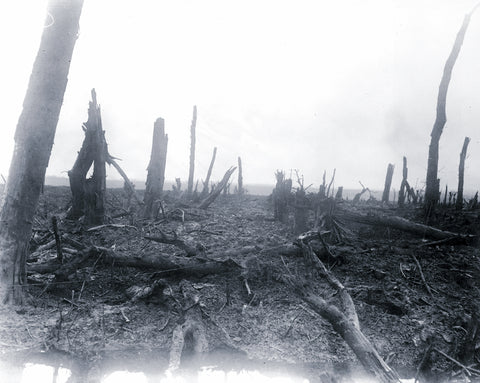
WWI’s Forgotten Victim: Nature
Millions of human lives were lost during World War I, but the damage sustained by the natural world was also catastrophic. While many studies and books about the war focus justly on the human experience, less attention has been paid to the war’s silent sufferers: trees, plant life and animals caught helplessly in shooting, bombardments or destroyed by humans for utilitarian demands caused by the war.
On the Western Front, such devastation was particularly severe. This British government war photograph shows damage caused to trees at Serre, France, allegedly by German shells, during World War I. During the war, entire forests were often reduced to splinters. In addition to being destroyed during combat, trees were cut down by soldiers for use as firewood, planks, fortification materials and for other wartime purposes. The French Forestry Service estimates that more than 350,000 hectares of forest were cut down — the equivalent of 60 years’ worth of tree harvests. Animal life in affected areas was often eradicated. Unexploded ordnance from the war remains, in addition to soil and groundwater contamination in some areas caused by chemical weapons.
“Where there are no dead, the earth itself is corpselike,” wrote French soldier Henri Barbusse in his novel “Under Fire,” based on his war experiences. Barbusse enlisted in the French Army and was awarded the Croix de Guerre. He later became a pacifist due to what he had witnessed in action.
Witnessing the horrifying damage to the natural world around them took a heavy psychological toll on many soldiers and civilians. Such sights had a profound influence on British war artist Paul Nash. Disturbed by the war’s effect on nature — and also by ignorance and indifference to it that he perceived in some people far from the frontlines — he dedicated many paintings to portraying the cataclysmic scenes he witnessed. Nash focused almost exclusively on landscapes. His aim was to remind humanity of the toll of war on many things we take for granted.
Despite the terrible damage, not all natural life in the war zone was doomed. In a unique twist of fate, a chestnut tree in Ypres, Belgium, survived both world wars. Reduced to a splintered stump during World War I, it grew into a four-trunked tree by World War II, and was spared from being chopped for firewood because its size and location made people afraid it would fall onto their houses. Lush and massive today, the chestnut stands near the Menin Gate. It was named Belgium’s “tree of the year” in 2020.
